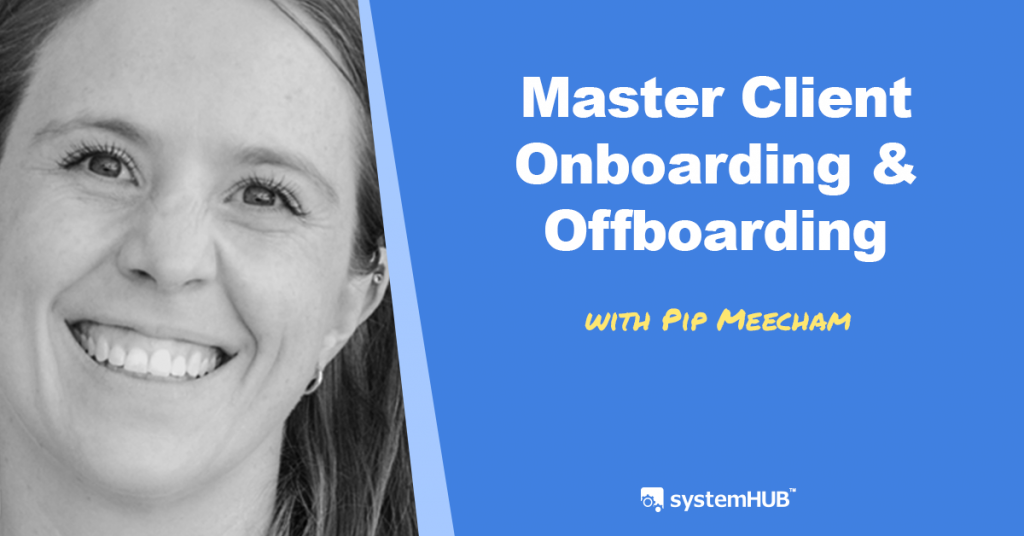Pip Meecham | The Perfect Client Onboarding & Offboarding System
- Department: Operations

Overview
This process elaborates steps on how business owners can provide their clients with systemized and consistent onboarding and offboarding experience. By following these steps, your onboarding and the offboarding process will be streamlined and clients are sure to be coming back to do business with you again in the future.
=-=-=-=-=-=
System Architect: Pip Meecham
Website: www.projectbox.com.au
Generated as part of the www.BusinessSystemsSummit.com
Video
The Process
Step 1: Map your current system processes.
- Visualize and jot down the processes and systems your business currently has. Feel free to go classic and do a pen and paper mapping.
- From there, pinpoint the holes or the areas that need improvement.
- Identify the things you’d like to happen as well as the things that should happen in your processes.
- Once it’s completely mapped out, identify all the different steps and bunch them into separate tasks.
- Try to delegate each task. Who could be doing what?
- If there are different team members that are currently in charge of a specific process, find the best team member who delivers the best result.
Step 2: Group the tasks.
- After mapping or listing out your business processes, identify which department each process/task should fall under.
- You may also divide the tasks according to the team member who does it.
- Pip suggests using different highlighter colours to group each task or you may also try using numbers to label them out.
Step 3: Consolidate your project management platform.
- Transfer the processes you’ve initially mapped out in your project management platform.
- According to Pip, it is much easier to transfer the “Whats” first and fill out the “Hows” of your processes later.
- Prioritizing the “Whats” over the “Hows” makes the implementation much easier.
- Using a project management system provides you with an advantage to move around and tweak your own systems.
- It also helps you to solidify and prove your processes.
- Using project management systems also boosts your team’s communication as commenting on certain projects is convenient and is directly beneficial both to your business and to your team members.
- Start-off transferring over your high-level processes then your sub-processes.
- Be sure to do a checklist for each task.
- Include documents or even hyperlinks that redirect you on how to execute that specific task properly.
- Having the checklists open at all times is not necessary as long as the person who executes the task knows it inside and out but having it open ensures consistency of execution.
Step 4: Create your process template.
- Once you’ve transferred your whole business process into your project management platform, create a template from it.
- Your template will be your canvas that you can duplicate and replicate anytime.
- As things change within your business, you can simply re-do your template.
- Pip suggests you create your process template right after transferring it into your project management tool as this task can be easily overlooked and forgotten.
- Creating your template makes delegating tasks much easier.
- It is an important core part of a business to keep everything together in one place, map it out properly, and know what’s happening at any given stage.
Step 5: Create your process documentation.
- Before implementation, start doing your documentations and how-to guides on how to execute all your tasks.
- These documentations and guides will then be linked to the tasks and subtasks you’ve mapped in your project management platform.
- Screen record the tasks. Pip suggests using Zoom as it’s free and convenient.
- It doesn’t matter if you make mistakes along the way. Pip says it is better if you make mistakes on your recording so your team members will see how to resolve the same mistake if they ever come across it.
- Can be catalogued even before the documentation process.
- Upload it in your cloud-based drive so you can link it to your project management tool.
- Let your documentation support your screen recordings. Keep them simple.
- Before sharing the tool with your team members, have someone test it out first.
- Get a person to do it who doesn’t normally do it.
- Get a team member to go over one system that belongs to a different department.
- Having a friend or a family go over it may also work.
- The gist of this is to ensure the simplicity of the process documentation and to avoid a single-person dependency.
- Once all the documentation has been linked to the tasks, discuss and explain to your team members how to utilize your project management tool.
- Make sure to also share the benefits of making use of the tool.
Step 6: Review and encourage process improvements.
- Encourage your team members to give their feedback once they’re on board and using your system process to make way for system improvements.
- Project management tools let you and your team members leave a note to system processes for any comments, questions or suggestions.
- If there are any corrections or questions about one or more of your system processes, you may choose to resolve them in a timely manner or right at that moment.
- Continue to review, optimize and improve your system processes.
Supporting Notes
- Outlining your onboarding and offboarding process ensures that your clients can have a perfect and consistent experience.
- This also signifies that you’re making your clients part of the business in actuality.
- Full utilization of these system processes by team members will guarantee efficiency when doing tasks.
- During the first step, it is fine to write down everything but think about the service standard that you want to provide to your clients. Incorporate these bits while you transfer your process into your project management tool.